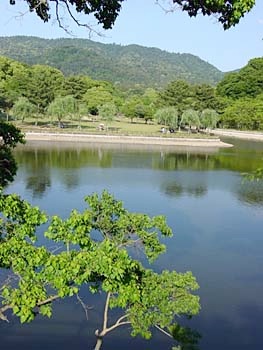

































If you're not exhausted from the bike ride, Nara Park is worth exploring, offering tranquil views like this one. In addition to the Nara bikepath you came here on, there are other, shorter bikeways going around the Nara Park area. If you have the time, get a map from the tourist office and have fun getting lost.
Nara has too many cultural and historical sites to count (particularly if you include not only Nara City but Nara Prefecture as well). But non-Japanese are probably most familiar with Todai-ji, or rather with its most famous occupant: the Daibutsu, or Big Buddha. This is what the temple itself (main temple in the Kegon sect of Buddhism) looks like. Even though it's supposedly the largest wooden building in the world, it's a pale imitation of the previous wooden building which was at least 1/3 larger.